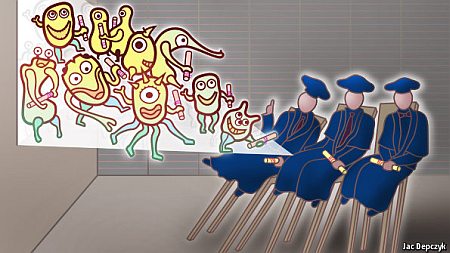scientific edition of Bauman MSTU
SCIENCE & EDUCATION
Bauman Moscow State Technical University. El № FS 77 - 48211. ISSN 1994-0408
16.02.2014
 The rise of online instruction will upend the economics of higher education.
The rise of online instruction will upend the economics of higher education.
Universties have not changed much since students first gathered in Oxford and Bologna in the 11th century. Teaching has been constrained by technology. Until recently a student needed to be in a lecture hall to hear the professor or around a table to debate with fellow students. Innovation is eliminating those constraints, however, and bringing sweeping change to higher education.
Online learning takes many forms. Wikipedia, a user-generated online encyclopedia, contains wonderfully detailed explanations. YouTube offers instruction on how to boil an egg as well as lectures on cosmology. Within many universities the online is displacing the offline. Professors publish course materials and videos of their lectures on the web. Students interact with each other and submit assignments by e-mail. Even those living on university campuses may nonetheless learn largely online, skipping lectures and reporting only for the final exam.
In America, bowing to the inevitable, universities have joined various startups in the rush to provide stand-alone instruction online, through Massive Open Online Courses, or MOOCs. Though much experimentation lies ahead, economics can shed light on how the market for higher education may change.
Two big forces underpin a university’s costs. The first is the need for physical proximity. Adding students is expensive—they require more buildings and instructors—and so a university’s marginal cost of production is high. That means that even in a competitive market, where price converges towards marginal cost, modern education is dear.
It is also hard to raise productivity. University lecturers can teach at most a few hundred students each semester—the maximum that can be squeezed into lecture halls and exam-marking rosters. Because it is so labour intensive higher education relies on large numbers of instructors paid relatively modest salaries.
Having invested in the production of a course, a provider’s incentive is to sell it to as many students as possible. After the initial cost is covered each additional unit sold is pure profit. A low price maximises registrations and profit. But as prices converge towards marginal cost, there will be little scope for undercutting the competition. Instead MOOCs are likely to compete on quality, Mr Tabarrok reckons. Higher production costs are a small price to pay to attract much greater numbers of students. Such markets often evolve into winner-take-all, “superstar” competitions. The best courses attract the most customers and profit handsomely as a result. In this respect online education may more closely resemble information industries such as film-making than service industries such as hair-cutting.
The market for textbooks already fits this description. New textbooks are costly to write and design but can be reproduced fairly cheaply. Not surprisingly, only four introductory economic texts account for half of the American market, according to Mr Tabarrok. Indeed, says Tyler Cowen, a co-founder of Marginal Revolution University, it is possible that textbook publishers are better equipped than universities to develop MOOCs profitably.
The market for instructors will also be transformed. The best teachers will be fabulously productive, reaching hundreds of thousands of students. There may therefore be far fewer of them, each compensated like superstars in the entertainment industry.
MOOCs’ low marginal cost is responsible for some of the bad press they occasionally receive. Consumers risk little by signing up, so both registrations and drop-out rates are high. Yet that is not necessarily a reflection of poor quality. An analysis of over 1000 studies of online-course results conducted by America’s Department of Education found that people who complete such courses do better on average than students in face-to-face instruction.
Full text of the article: The Economist
Photo: from The Economist site
| Authors |
| Press-releases |
| Library |
| Conferences |
| About Project |
| Phone: +7 (915) 336-07-65 (строго: среда; пятница c 11-00 до 17-00) |
|
||||
| © 2003-2024 «Наука и образование» Перепечатка материалов журнала без согласования с редакцией запрещена Phone: +7 (915) 336-07-65 (строго: среда; пятница c 11-00 до 17-00) | |||||



